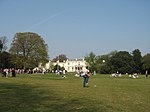Our Lady of the Annunciation Church, Liverpool
19th-century Roman Catholic church buildings in the United KingdomGothic Revival architecture in MerseysideGothic Revival church buildings in EnglandGrade II* listed buildings in LiverpoolGrade II* listed churches in Merseyside ... and 3 more
Redemptorist churches in the United KingdomRoman Catholic churches completed in 1858Roman Catholic churches in Liverpool

Our Lady of the Annunciation Church is a Catholic parish church next to Bishop Eton Monastery in Childwall, Liverpool. It was built from 1857 to 1858 by the Redemptorists and was designed by E. W. Pugin. It is on the Woolton Road, opposite the Hope Park campus of Liverpool Hope University and close to Our Lady's Bishop Eton Primary School. It is a Grade II* listed building.
Excerpt from the Wikipedia article Our Lady of the Annunciation Church, Liverpool (License: CC BY-SA 3.0, Authors, Images).Our Lady of the Annunciation Church, Liverpool
Woolton Road, Liverpool Childwall
Geographical coordinates (GPS) Address Phone number Website Nearby Places Show on map
Geographical coordinates (GPS)
| Latitude | Longitude |
|---|---|
| N 53.389 ° | E -2.895 ° |
Address
Our Lady of the Annunciation Bishop Eton Church
Woolton Road
L16 8NQ Liverpool, Childwall
England, United Kingdom
Open on Google Maps






